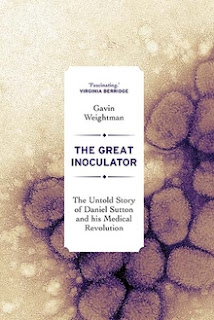 The Frozen Water Trade, and The Industrial Revolutionaries.
The Frozen Water Trade, and The Industrial Revolutionaries.
Weightman applied the “Page 99 Test” to his latest book, The Great Inoculator: The Untold Story of Daniel Sutton and his Medical Revolution, and reported the following:
This page includes an account of the way in which Daniel Sutton and his brothers, all who made their living offering inoculation against smallpox in the 1770s in England, were branching out into new and a less certain fields. Daniel had made his fortune offering his skills to a middle class clientele who recognised his exceptional gifts. He had devised a way of injecting a small piece of smallpox infection, taken from a sufferer, into the arm of his patients. He accommodated them in rented houses where they ate and slept for weeks at a time until they were immune and no longer infectious. Inoculation was, for the most part, a luxury for those who could afford the hefty fees. But in time Sutton faced many rivals and was forced to adopt a new business plan. He would get together a scheme in which the wealthy funded the inoculation of the poor.Visit Gavin Weightman's website.
Daniel’s brothers, who were at times his acolytes and at other times his rivals, followed suit plying their trade in different parts of the country. A Mr Sutton in Newcastle-upon-Tyne who introduced himself as “ brother of Mr Daniel Sutton in London” proposed to “ inoculate the poor with the concurrence and support of the Nobility (and others) by subscription.. At this time, when the labour of the inferior mechanic and husbandman will scarcely provide clothing for their family…it is hoped than any proposal toward the benefit and preservation of that body of people will meet with due encouragement.”
By the time this advertisement appeared in 1770 general inoculations of whole towns and villages had become quite common. This got round the problem of the infectiousness of those inoculated. If there were just one or two treated in community they could start an epidemic if not kept in isolation. If everyone was inoculated at the same time there was no danger. The Suttons were called upon to carry out these mass inoculations which were lucrative. But an innovation introduced in 1798 wiped out Daniel’s reputation as the Great Inoculator.
Another country surgeon, Edward Jenner, successfully treated a boy not with smallpox but with a less virulent disease called cowpox. Jenner dignified cowpox with a Latin name variola vaccinae ,or “smallpox of the cow.” Jenner’s “vaccination” was safer than Sutton’s inoculation chiefly because those vaccinated could not spread smallpox. Jenner owed a great debt to Sutton but he never acknowledged it. The Great Inoculator seeks to restore Sutton’s rightful place in medical history.
The Page 99 Test: Eureka: How Invention Happens.
--Marshal Zeringue



